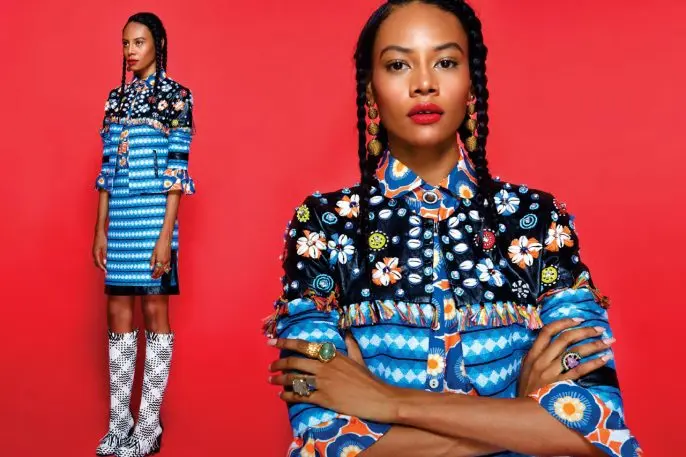Before Autumn Adeigbo launched her eponymous eco-fashion brand for professional women, she was a hard-working student at Parsons dreaming of a career as a designer. And like many of her peers, the quickest way she saw to make that dream come true was to get a foot in the industry’s door via an internship.
For Adeigbo, landing that internship was partly about skill and partly about being in the right place at the right time. “I met Betsey Johnson one night after class on the street right outside Parsons, and she hired me for the position [of production intern].”
This all happened in the years before the country was plunged into recession, yet Betsey Johnson (like other fashion brands) didn’t pay Adeigbo to work there. “That was just the way things were at the time,” says Adeigbo. “No one working in fashion was paid for internships. If we were lucky, we got school credit,” she says.
After six months doing basic entry-level tasks for Betsey Johnson, Adeigbo landed a second (unpaid) internship as a stylist’s assistant with Andrea Lieberman: Culture & Reality. (Lieberman is now founder of contemporary fashion label ALC). “With Andrea, I was part of the team that dressed Jennifer Lopez, Gwen Stefani as she did her solo L.A.M.B. album debut, the Pussycat Dolls as their song “Don’t Cha” came out, and many other incredible projects,” Adeigbo recalls. She also earned class credits for those gigs.

By the time she’d graduated from Parsons, Adeigbo parlayed that internship into a paid freelance position. However, in fashion, the transition to temp work or freelance, or a low-wage, entry-level job is fairly common, even though the hours are long, and the grueling demands might seem like they were cooked up in a Hollywood screenplay, but are all too real.
What’s worse is that a 2016 survey by the National Association of Colleges and Employers (NACE) found that less than half (43.9%) of over 9,000 students surveyed who were working with private for-profit companies who didn’t pay them received job offers. Even those who did get paid internships didn’t always get a full-time job. The report reveals that nearly one-third (28%) of those who did have fully paid internships didn’t receive job offers.
Still, internships are inexorably tied to the career landscape in the U.S. and across the globe. The NACE estimates that there are as many as 300,000 students participating in some form of pre-employment apprenticeship in the U.S. each year. How did they gain such an enduring position, especially given the questionable pay practices and no guarantees of translating to a real job?
The origin of unpaid internships
We can thank the ancient cultures. Apprenticeships flourished in Egypt, Greece, and Rome, as well as in Asia thousands of years ago. During medieval times in Europe, a system of apprenticeship was supervised by masters in craft guilds as well as in town governments.
The apprentices (or their families) would pay the master to let them work alongside and learn their particular craft. During the time a young person would apprentice (sometimes as long as nine years), the master provided room and board. In craft, as in some current industries, those who were bankrolled by family had an advantage, and nepotism was rampant. According to Britannica, “Apprenticeships in some trades came to be highly valued, and a family would have to pay a master a large sum of money for him to enroll their son as an apprentice. Often apprenticeships came to be restricted to the sons or other relatives of masters.”
The Industrial Revolution is where apprenticeships and the concept of modern internship diverge. Manufacturing required different skills, so apprenticeships were replaced by vocational schooling. Alongside this, job training that coincided with university studies began to be developed.
The Morrill Act of 1861 (Land Grant Act) provided funds to establish colleges devoted to agriculture and mechanical arts, so the institutions created courses with more practical education. In 1899, the cooperative system of education was proposed at Lehigh University in Pennsylvania. The first class in 1906 had 27 students that alternated working at 13 companies and going to school weekly. They were paid 8¢ to 10¢ an hour (that’s around $2.80 an hour today if you factor in inflation).
The word “intern” itself began in the medical community to refer to a person who studied medicine but didn’t yet have a license to practice. Then in the 1960s, internships like the ones we know today began to gain traction across disciplines. And some very famous people got their careers started during internships. Bill Gates was once a congressional page, and Oprah Winfrey worked at a CBS affiliate during her college years.
Backlash
But just because you can get a big break doesn’t mean it’s okay to not get paid for the work you’re doing. A raft of class action lawsuits were leveled at companies such as Conde Nast, Fox Searchlight, Hearst, and others between 2011 and 2013, prompting the courts to take another look at the legality of these working arrangements. Some of these companies quietly settled out of court, and Conde Nast stopped employing interns altogether.
For its part, the U.S. Department of Labor (DOL) changed its requirements for classifying interns versus employees last January. Among the seven criteria, the DOL states that there is no expectation of compensation by either the company or the intern. “Any promise of compensation, express or implied, suggests that the intern is an employee–and vice versa,” they say. There’s also a tie to education and class credit that is necessary for an internship and “the extent to which the intern’s work complements, rather than displaces, the work of paid employees while providing significant educational benefits to the intern.” Finally, the criteria protect the employer from having to hire the intern by stating, “The intern and the employer understand that the internship is conducted without entitlement to a paid job at the conclusion of the internship.”

“I’m a fashion designer now, and to this day, my experience working with Betsey Johnson is the only time that I ever worked at a designer’s headquarters,” she says. Betsey Johnson’s showroom was the only time Adeigbo had access to the entire process of a global fashion brand: from inspiration to sourcing, design, pattern making, and production, sales, and publicity. “There is also something to be said for being able to see an icon like Betsey every day, and know that my dream was actually possible to achieve because of her presence,” adds Adeigbo. “You can’t put a price tag on that.”
Recognize your brand’s excellence by applying to this year’s Brands That Matter Awards before the early-rate deadline, May 3.
